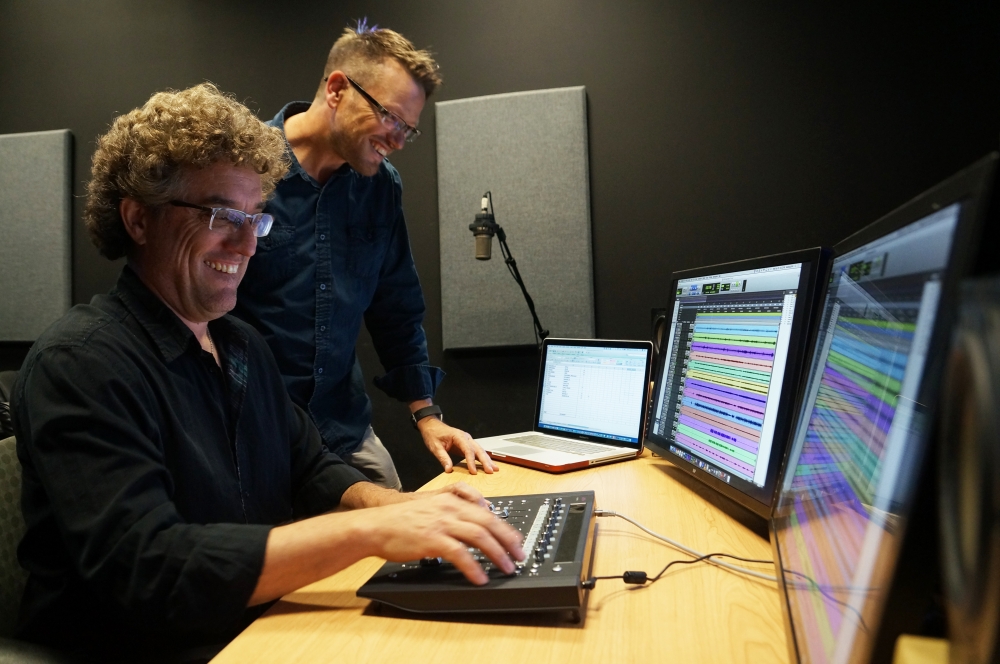
The Art of Sound
Think about the last movie you saw. Whether action, comedy or romance, it was a carefully mixed blend of sight and sound. Every line of dialogue, song and sound effect that came through the speakers was crafted by a professional sound editor to complement the images on the screen.
Now, UC Santa Barbara students have a chance to master this complex art, in a new, modern sound-mixing suite and workshop-style sound design class.
The Lazarus Sound Lab, part of UCSB’s Department of Film and Media Studies, promises to train students in the latest programs and techniques for capturing, editing and mixing high-quality sound. Named for donor (and former screenwriting instructor) Paul Lazarus and his family, the lab is the brainchild of Chris Jenkins, the department’s head of production. He saw an opportunity to provide student filmmakers with the best technology available by introducing professional sound editing software and production gear. Additionally, renovations to an existing screening room were made possible by donor and UCSB alumnus Scott Frank (’82).
Under Jenkins’ direction, the department invested in top-of-the-line equipment, recruiting local audio expert Chris Pelonis (who has designed studios for George Lucas’s Skywalker Ranch, musician Jack White and Disney) to convert an existing editing room to Dolby 5.1 surround sound, the film industry standard. They also replaced outdated computers and hired experienced audio engineer and sound production instructor Sven Holcomb, who designed a digital audio workstation (DAW) from the ground up.
Holcomb has worked across industries, producing and engineering sound for albums, feature films and documentaries. In his course, students learn how individual tracks — dialogue, music, sound effects, foley and ambient noise — come together, layer by layer, to make the intricate suite of sounds we hear in a film. By understanding the science of sound and making slight tweaks to each track, Holcomb teaches, filmmakers can achieve the best possible audio quality.
His expertise and hands-on approach to teaching have been a huge benefit, say the students, who are taking the skills learned in Holcomb’s class and applying them to their own projects with stellar results. “During his classes, Sven likes to share anecdotes of his experiences in the industry, most of which were opportunities he had because he was so willing to learn and teach himself,” said Amanda Nguyen, a junior majoring in film and media studies. “As a result, I stepped up to the challenge of teaching myself sound design for animated films and ended up making half of a film by myself. I now see filmmaking as a series of challenges and goals that I can learn from.”
Through Holcomb’s curriculum, students learn how integral sound is to filmmaking, from capturing quality audio on set to applying filters that can smooth out distracting background noises. Holcomb contends that good sound design can transform a mediocre film into a great one. “You can watch a terrible image with amazing sound and you’ll have a wonderful experience,” he said, “but if you watch an amazing image with bad sound, it will affect your experience negatively.”
“The most critical thing I learned from Sven would have to be his emphasis on how important preproduction and post-production are in sound design,” said Nguyen. “He validated that there’s no such thing as too much effort or attention to detail when it comes to sound, and he made me realize that sound is literally half of a film.”
Combined, the renovated space, new equipment and invaluable instruction have UCSB student filmmakers taking sound design seriously, both for their undergraduate projects and for their future careers. “This suite allows students to have an environment where they can mix and they can learn, and [they] know that whatever they do in here will transfer to a theater environment,” said Holcomb. “It allows them to use the same technology and software they’ll be using when they go out into the professional world.”
Thanks to the updated sound program, students are increasingly rethinking their career ambitions, according to Jenkins. “In years past, graduating students might be thinking about writing or cinematography or even editing, but very few have been interested in sound,” he said. “Now we have a bunch of them interested in sound. They have a new avenue to explore after graduating, and it’s probably the most employable avenue.”



